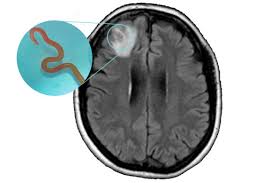
A 64-year-old woman who had been suffering from depression and experiencing increasing forgetfulness, received the astonishing news that an 8cm-long parasitic roundworm was the actual cause.
The English woman, who was living in New South Wales, Australia, was sent for an MRI scan which revealed the creature’s alarming existence within her brain.
The unfortunate lady, who has not been named, was said to have been “very pleased” to have finally received an explanation for her symptoms, which had been present and getting worse over a period of more than 12 months; before undergoing a small surgical procedure to carefully remove the uninvited guest.
The case is unprecedented in medical history, and has been documented in the journal of Emerging Infectious Diseases.
Incorrect diagnosis
The “victim” was first admitted to hospital in January 2021 after three weeks of abdominal pain and chronic diarrhoea, followed by a dry cough and constant night sweats. Despite comprehensive tests, the results remained inconclusive.
Eventually, she received a diagnosis of pneumonia originating from an undisclosed source and was prescribed a course of steroids.
Remarkable discovery
Her condition however continued to worsen, contributing to the depressed state of mind. By the time 2022 arrived she was referred to a Canberra hospital and it was here that the remarkable revelation was uncovered.
Originally it was described as an unusual “string-like structure”, but eventually it became apparent that it was in fact a motile helminth, otherwise known as a parasitic roundworm, which was incredibly living in the right frontal lobe lesion of her brain.
Still wiggling around
Neurosurgeon Dr Hari Priya Bandi performed the delicate surgery to remove the “intruder” which measured 8cm in length and 1mm in diameter. The doctor described the case as a real mystery when it was initially presented to her and her team, with what was seen as a “distinct abnormality” within the brain, rapidly changing over time.
She admitted to being shocked, when with the use of forceps she found the parasite was happily wiggling around as she gently lifted the entity from the woman’s brain.
Dr Bandi remarked afterwards: “It was surprising for us and not what we’re used to at all when we do such planned surgery… but it was good to get an answer for this woman who had been suffering for so long.”
Identification made
The worm was taken to the Commonwealth Scientific and Industrial Research Organisation (CSIRO) in Canberra where it was “sliced for genetic typing” and identified as a third-stage larva of the Ophidascaris robertsi nematode species, which indicated its affiliation with a family of parasites, typically exclusive to snakes.
Scientific theory
This parasitic worm lives in the digestive tracts of carpet pythons which are indigenous to the Australian state of New South Wales. The woman involved in the drama lives near to a lake area which is commonly inhabited by these pythons.
Scientists have put forward a theory that she may have become infected by inadvertently ingesting the worm’s eggs by using edible native grasses for cooking which had been tainted with snake faeces. Once hatched within her body it is thought that the worm worked its way up to her brain over a period of time.
Woman’s health still being monitored
The details of this case are only now being released to the public domain despite the surgery being carried out over a year ago. Medical experts are emphasising the significance of ongoing monitoring, as studies on rats have demonstrated that this particular worm’s eggs can endure within the body for over four years.
The medics also let it be known that whilst this worm is exclusive to Australia, there are similar species located in other parts of the world, which means that there is the potential for further occurrences in the future elsewhere.






0 Comments